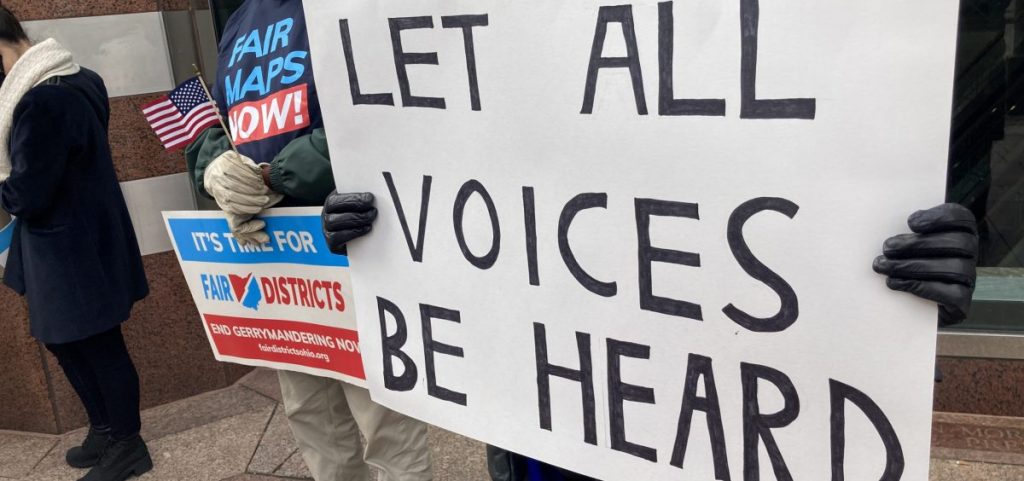News
From constitutional reform to crisis, Ohio redistricting saga nears federal intervention
By: Andy Chow | Statehouse News Bureau
Posted on:
COLUMBUS, Ohio (Statehouse News Bureau) — A saga that began nine months ago to implement Ohio’s new redistricting process is now heading towards a federal court decision that could dash the hopes of advocates fighting against partisan gerrymandering.
On August 6, 2021, the seven members of the Ohio Redistricting Commission convened and took the oath of office. This was the first meeting of the commission which was established by a constitutional amendment. That amendment was overwhelmingly approved by voters in 2015.
Voting rights advocates went into the process cautiously optimistic.
“This is the chance for the public to be engaging, making sure that mapmakers are upholding the letter and spirit of those ballot initiatives,” said Jen Miller, executive director of the League of Women Voters of Ohio.
From that first August meeting until mid-September, the commission held more than a dozen public hearings in 11 different cities around Ohio.
After days of negotiating, the commission eventually adopted its first set of maps at 12:02 a.m. on September 16 – two minutes past the constitutional deadline.
The five Republican commissioners approved the maps while the two Democratic commissioners voted against the plan.
Timeline: Follow the various twists in the Ohio Redistricting Saga
Senate President Matt Huffman (R-Lima) argued for the maps, which retained a Republican supermajority in both chambers.
“I think it’s important that this commission vote on a map that is constitutional,” said Huffman.
But then-House Minority Leader Emilia Sykes (D-Akron) slammed the maps as a clear violation of Ohio’s anti-gerrymandering law.
“The maps adopted today go to absurd length to create a Republican monopoly on legislative power that they have not earned at the ballot box,” said Sykes.
Three groups – representing voting right advocates, community organizations, and a national Democratic group – each filed lawsuits against the maps. Those lawsuits took the redistricting fight to the Ohio Supreme Court where Chief Justice Maureen O’Connor, a Republican, questioned the GOP’s definition of proportional representation.
The first maps gave Republicans at least a 63% advantage in a state that splits about 54% Republican and 46% Democratic.
“There’s no equivalent number or representation of all of the other parties – Democrat or Democratic leaning independents that voted. There’s no accounting for their vote,” said O’Connor during oral arguments in December 2021.
In January, the Ohio Supreme Court ruled those maps were unconstitutional in a 4-3 decision. O’Connor joined the three Democratic justices in the majority opinion to say the maps failed to proportionally represent Ohio’s voter makeup.
That sparked what became a round of redistricting table tennis between the commission and the supreme court. They would volley back-and-forth with the commission adopting new maps and the supreme court rejecting those maps.
Republican commissioners would face criticism from Democratic commissioners and advocates who insisted that it was possible to draft constitutional maps. The Democratic members claimed the Republicans were ignoring the supreme court in order to keep an advantage in the House and Senate.
In March, without constitutional state legislative district maps in place, Secretary of State Frank LaRose, a Republican, removed those races from the primary ballot.

“Given this impasse, federal law requires that there be an ability to effectively vote for your state representative and we need to have the federal court draft districts that will be in conformity with the federal laws and federal constitution,” said Brey.
A turning point came on March 18, when a panel of two Republican-appointed federal judges and one Democratic-appointed federal judge got the case.
They ruled last month, 2-1, that they would order unconstitutional Ohio House and Ohio Senate district maps be put in place if the two sides cannot reach an agreement on a final plan by May 28.
Those already invalidated maps, known as Map 3, were approved by a majority of Republicans on the commission and ruled unconstitutional for giving the GOP an unfair advantage.
Miller said the federal ruling pulls the rug out from under everyone fighting for fair maps, she added “It rewards the Republicans on the redistricting commission for continuing delays and ultimately gerrymandering.”
Over the last nine months there have been dozens of redistricting commission meetings, four drafts of adopted maps, four rounds of rejected maps, three members who have left the commission, and a separate fight over congressional redistricting that’s been put on hold.
The process has also become costly. Mapmakers and consultants have been paid hundreds of thousands of dollars by the redistricting commission’s task force. Legislators allocated $9 million for local boards of elections that needed additional help to carry out the May 3 primary. To top it off, a second primary could cost the state up to $25 million.
If the federal ruling is carried out, state redistricting officials will have to come back to the table again to redraw legislative districts for 2024.
9(MDU1ODUxOTA3MDE2MDQwNjY2NjEyM2Q3ZA000))

